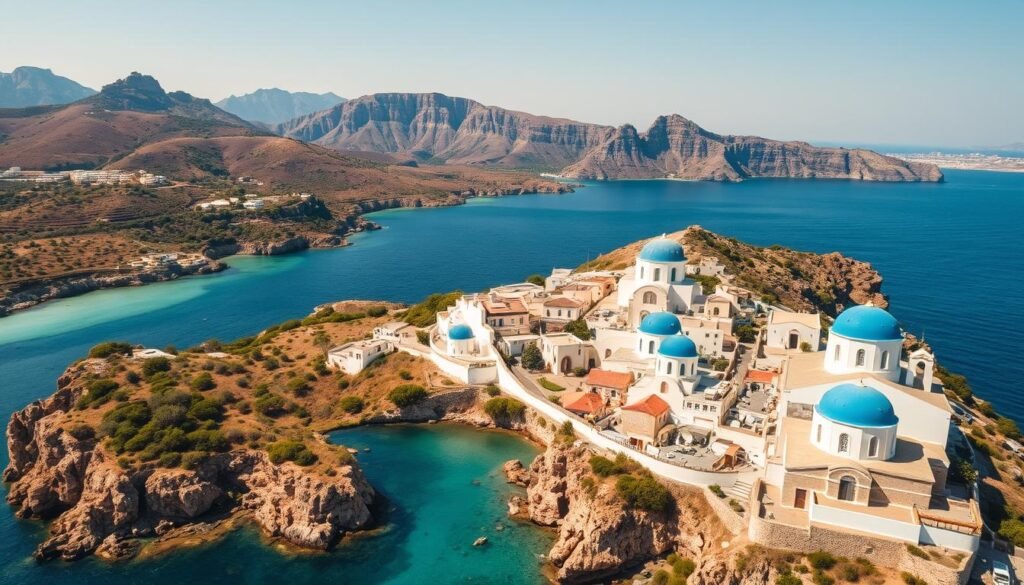Here’s a number that surprised me: Greece has over 6,000 islands, yet only 227 are inhabited. That scale reshaped how I planned every trip.
I write from years of island hopping across the greek islands and the mainland. I’ll help you match a destination and schedule with your style and budget.
Expect clear comparisons of island groups, practical ferry options, and notes on weather and the best time of year to go. I point out the views that stopped me and the beaches I kept returning to.
This guide is practical. I share routes that save time, highlight services and boutique stays I loved, and lay out a first-trip plan that mixes Athens and islands for balance.
Key Takeaways
- I used long-term travel experience to make quick comparisons.
- Island groups like the Cyclades and Ionian shape efficient ferry routes.
- Crete extends warm weather for longer trips later in the year.
- Athens makes a handy city-break hub before island hopping.
- I point out standout views, beaches, and stays that matter most.
- Expect timing tips to avoid crowds and get better value.
Santorini: Caldera Views, Volcanic-Sand Beaches, and Iconic Sunsets
The caldera grabbed my attention from the first ferry whistle, and it never let go. Santorini sits in the southern Aegean Sea, part of the Cyclades, and its dramatic rim shapes everything here.
I walked the Fira-to-Oia cliff path for the architecture and those postcard sunsets. Oia at dawn felt like my quiet secret, and at dusk the sky put on a show.
The island packs volcanic-sand beaches—Red Beach and the black strands at Perissa and Perivolos—with crystal-clear waters and unusual rock formations. Boat tours into the caldera and swims near Nea Kameni were highlights; bring reef shoes for pebbly entries.
Highlights I Recommend
- Akrotiri for Bronze Age ruins and context.
- Volcanic vineyard tastings for mineral-rich wines.
- Stays in Imerovigli or boutique hotels like Dana Villas & Infinity Suites for private terraces and sea views.
- Go late spring or early fall to dodge peak summer crowds.
- Book dinners and transfers in advance during summer months.
“Plan your time of day and neighborhoods to reclaim serenity from the bustle.”
Mykonos: Cycladic Charm, Sandy Beaches, and Electric Nightlife
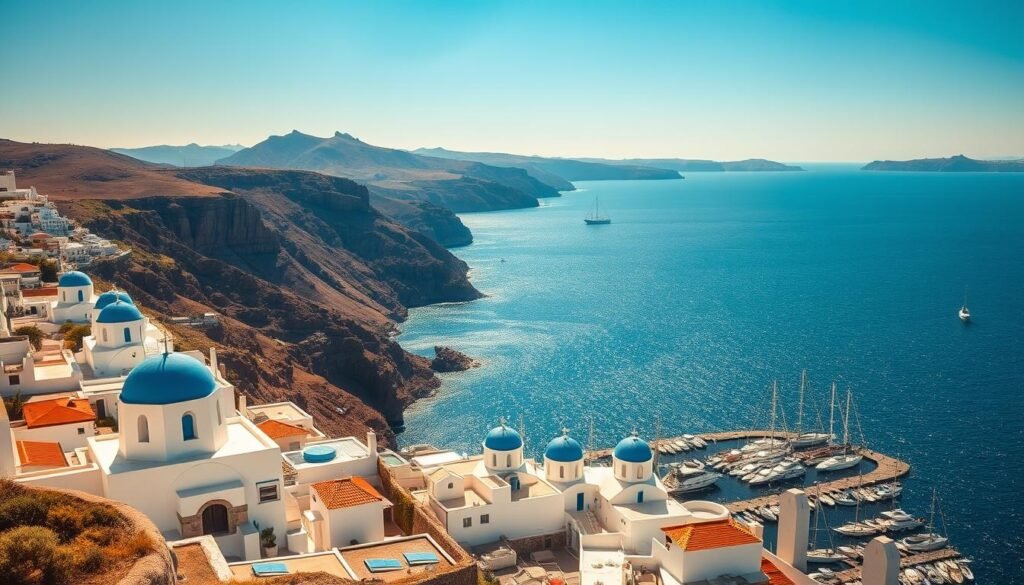
Mykonos hit me with a bright palette of whitewashed lanes and a sea breeze that never quit. The Cyclades island blends classic Cycladic architecture with a confident social scene. I loved how compact the location felt—short rides from town sent me straight to sand and sea.
Little Venice, windmills, and dazzle
I wandered Little Venice’s balconies as waves lapped below the windmills. The Aegean Sea breeze framed every view. Paraportiani and the cube houses made for perfect photos and relaxed strolls.
Beach options and sandy beaches
My days mixed energy and calm. Paradise served up high-energy music and crowds, Ornos offered convenience, Platis Gialos had golden sand, and Elia gave space to breathe.
Tip: I booked loungers early and used water taxis to hop between bays.
After dark: clubs, restaurants, and one unforgettable party
Nightlife here is electric. Open-air bars and waterfront restaurants fed long nights. The cliff-top Cavo Paradiso party reached sunrise with waves below.
“Mix town strolls, windmill sea views, one big night out, and a quiet recovery beach.”
- I stayed at WhiteArt Suites for a calm base near the action.
- Late spring or early fall kept crowds lower and summer heat gentler.
- The island’s small size made hopping between beaches quick and easy.
Athens: Ancient Landmarks, Modern Energy, and Athenian Riviera
![]()
Athens unfolded for me as a layered city where ruins sit next to buzzing cafés and modern art.
I felt the city’s rich history the moment I climbed toward the Acropolis. The Parthenon and Ancient Agora make Athens a living museum. I moved from one site to the next with ease and found surprises at every corner.
The neighborhoods shaped my days. Plaka offered neoclassical lanes and souvenir stalls. Thissio became my café stop, and Syntagma was useful for transit and lively dining choices.
I chased rooftop sunsets at bars like A for Athens and watched the Acropolis glow. Those views felt like a small rite of passage. Later, I escaped to the Athenian Riviera for a seaside breeze and a quick beach cove.
“With smart timing—early starts and late-spring travel—I skipped queues and enjoyed softer light over the ruins.”
- I loved how classical architecture blends with modern facades.
- Restaurants around Syntagma offered seasonal, market-fresh menus.
- Athens is compact in area but rich enough that a few days never felt long enough.
| Feature | Where I Went | When I Recommend |
|---|---|---|
| Key sites | Acropolis, Parthenon, Ancient Agora | Early morning, late spring |
| Neighborhood vibe | Plaka (quaint), Thissio (cafés), Syntagma (urban) | Stroll afternoons, evenings for restaurants |
| Views & leisure | Rooftop bars, Athenian Riviera beaches | Sunset hours, warm-season afternoons |
| Logistics | Central location for island itineraries | Start or end an island trip |
Crete: Pink Sands, Deep History, and Big-Island Adventure
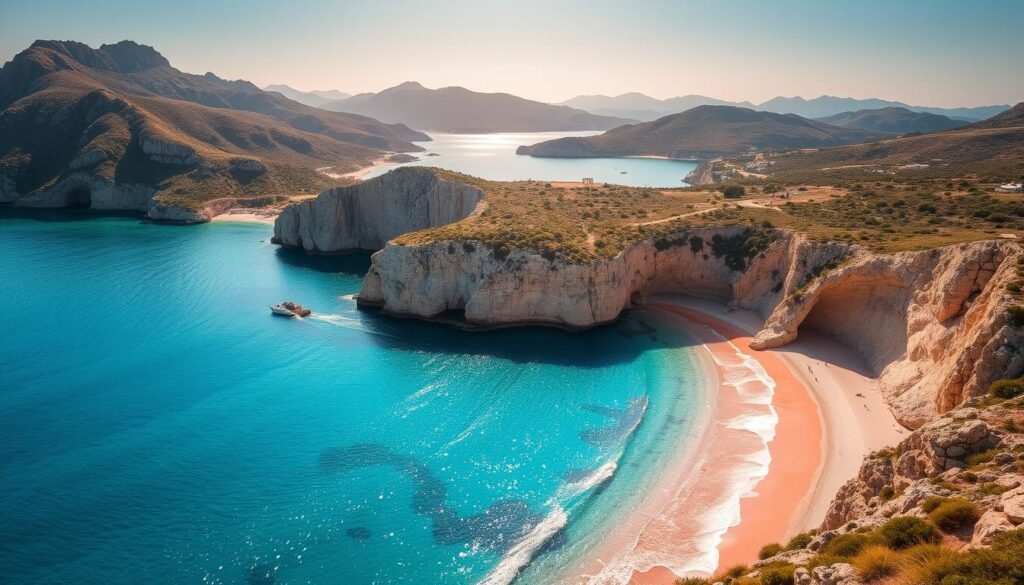
The first view of Crete’s coastline made me rethink what a Mediterranean island can hold. This island spans 8,336 sq km and sits about 99 miles south of the mainland, so days here can stretch long and varied.
Beaches I rate: I came for Elafonissi’s pink shimmer and Balos’s turquoise lagoon. Quiet coves along Chania’s coastline offered calm evenings after full days of exploring.
History highlights: Standing at Knossos felt like stepping into Minoan myth. The layers of history here give the whole area a strong sense of place and story.
Nature thrills: I hiked Samaria Gorge and finished at the sea — those mountain-to-coast landscapes were unforgettable. The island’s area means renting a car or planning each region helps you see more.
Why Crete works year-round: Warm weather often runs from April through November, so shoulder months let you swim, enjoy local cuisine, and dodge heavy crowds.
“I stayed in Chania for lantern-lit nights and booked a boutique room at Elounda Stories Boutique Hotel for relaxed mornings.”
For practical tips and regional logistics, see this Crete travel guide.
Rhodes: Medieval Old Town Meets Turquoise Bays
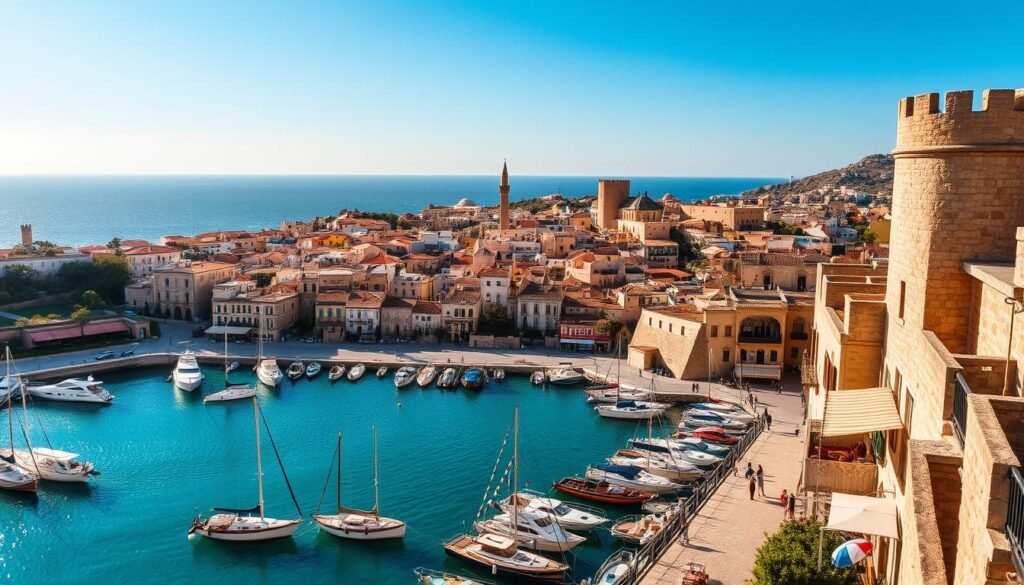
I found Rhodes easy to fall for—stone walls one moment, turquoise water the next. This large Dodecanese island sits near Turkey and basks in over 300 sunny days a year.
I lost track of time roaming the UNESCO-listed Old Town. The Street of the Knights, narrow courtyards, and fortified walls felt like a living museum. Architecture fans will notice medieval fortifications beside later Italian-influenced facades.
UNESCO-listed walls, Street of the Knights, and timeless charm
Lindos charmed me with whitewashed houses beneath its acropolis. I hiked up for wide views and a sense of layered history. I timed visits for early morning to beat crowds and get quiet photos.
Beach days: Tsambika, Agathi, and Anthony Quinn Bay
Beach time was easy to plan. I split days between soft-sanded Tsambika, mellow Agathi, and the gem-toned water at Anthony Quinn Bay. The seaside restaurants and casual tavernas made late afternoons linger.
- Hotels: I stayed near Lindos for quick bay access — White Olive Premium Lindos was a solid location.
- Practical tip: The island’s area rewards a car rental if you want flexible day trips across towns and bays.
- Why go then: Late spring or early fall keeps heat and crowds lower while the Aegean Sea stays inviting.
“Rhodes balances history, sandy beaches, and a lively but varied nightlife—pick a base and you’ll find your groove.”
Zakynthos: Shipwreck Drama, Blue Caves, and Sea Turtle Encounters
![]()
On Zakynthos, sheer cliffs reveal a shipwreck cove that looks unreal from the high viewpoints. I chased those lookout angles until I found the perfect frame of the rusted hull and electric-blue water.
I took boat trips to the Blue Caves where light turned the sea an impossible turquoise. Small boats let me slip into mirror-like coves and spot the shimmer of crystal-clear waters.
Laganas and Kalamaki: sandy beaches and clear bays
My days balanced lively Laganas with laid-back Kalamaki. The long sandy beaches fit both daytime lounging and active water time.
Snorkeling with loggerhead turtles around Marathonisi
Snorkeling off Marathonisi was a highlight. I spotted loggerhead turtles in calm waters and kept a respectful distance while they fed.
- I loved staying at a suite with a private pool—Mon Repo Secret Suites made slow mornings easy.
- Zakynthos Town offered nightlife and breezy promenades if I wanted a casual evening or a late party.
- The island’s villages like Bochali show Venetian-inspired architecture and postcard views over changing landscapes.
“Between turquoise coves, turtles, and easy nightlife options, Zakynthos is a flexible destination that suits both calm and lively moods.”
Corfu: Venetian Grace, Green Hills, and Ionian Sea Views
Corfu surprised me with sudden green slopes that seem to tumble straight into the Ionian. The island spans 593 sq km and mixes Venetian architecture with olive-studded hills. Corfu Town invites slow walks along arcades, fortress ramps, and café-lined squares.
UNESCO Old Town strolls and seaside fortresses
I spent hours admiring Venetian arcades and British-era touches that layer the town. The fortress ramps give sweeping views and easy access to cozy restaurants tucked in narrow lanes.
Paleokastritsa and beyond: best beach and bay picks
Paleokastritsa lived up to the hype—crystalline coves, green hills tumbling to the waters, and viewpoints made for perfect photos. I paired Achilleion Palace and Angelokastro with lazy beach afternoons and seaside taverna lunches.
“Corfu gave me a calm rhythm: olive-grove drives, village discoveries, and afternoons spent swimming in teal waters.”
- I rented a car and found quiet beaches tucked between villages.
- Art Hotel Debono was a comfortable base when I wanted a calmer life pace.
- The island’s location makes it an easy starting point for Ionian islands if you have extra days.
Kefalonia: Towering Cliffs, Turquoise Bays, and Storybook Villages
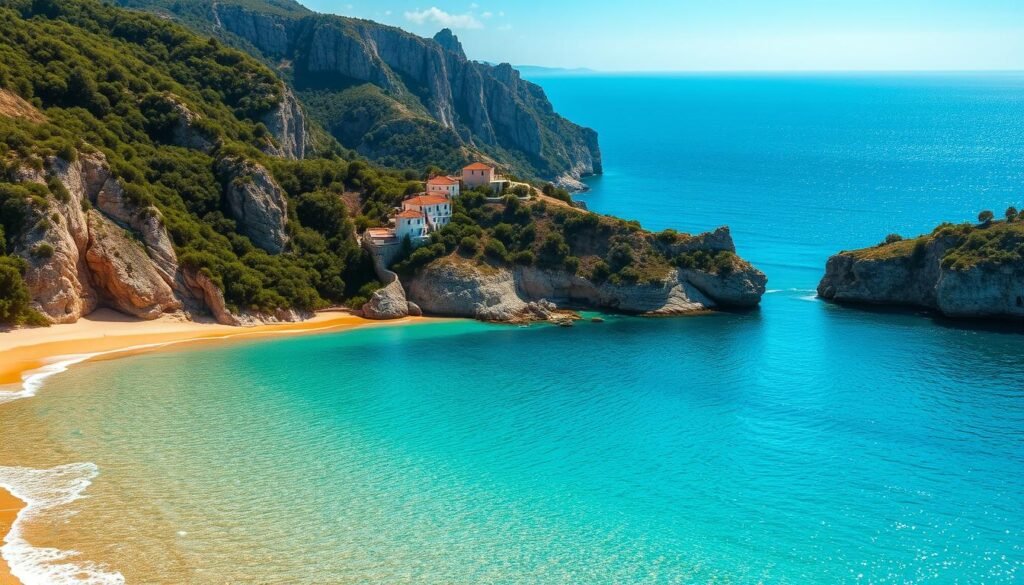
The first time I crested the road above Myrtos, the sea below looked like a painted slice of turquoise. Myrtos Beach stunned me with white pebbles and vertical cliffs that frame a bowl of vivid water.
I paddled a rowboat across Melissani Cave and watched light flood the underground lake through the collapsed roof. That skylight moment felt almost private.
Assos is pure postcard charm: pastel houses hugging a slim isthmus and a calm harbor perfect for a dip. I paired mornings of hiking on Mount Ainos with slow afternoons sipping iced coffee in village squares.
Myrtos and coastline highlights
I mixed visits to Antisamos and Makris Gialos to compare sand texture and water color. Each cove showed different coastal landscapes and rock formations.
“Routing days by coast segment saved me time and let me linger where light and wind were best.”
- I found a boutique stay—Thalassa Boutique Hotel—ideal for sunrise coffee and sea-facing rooms.
- Driving switchbacks to Mount Ainos rewarded me with island panoramas on clear days.
- The island’s karst cliffs add drama; bring comfy shoes for lookouts and short hikes.
| Feature | Highlight | When I Recommend |
|---|---|---|
| Iconic beach | Myrtos Beach (white pebbles, steep cliffs) | Late spring or early fall for calmer waters |
| Underground sight | Melissani Cave (rowboat over illuminated lake) | Midday for best light |
| Village charm | Assos (harbor, pastel houses) | Afternoons for relaxed swims and cafés |
Kefalonia is the largest Ionian island after Crete and easily pairs with nearby islands like Zakynthos on a week-plus itinerary. Its area feels compact when you route days by coast, and the waters keep calling for another swim.
For more detail on logistics and local tips, see the regional guide at Kefalonia overview.
Naxos: Wide Sandy Strands, Mountain Villages, and the Portara
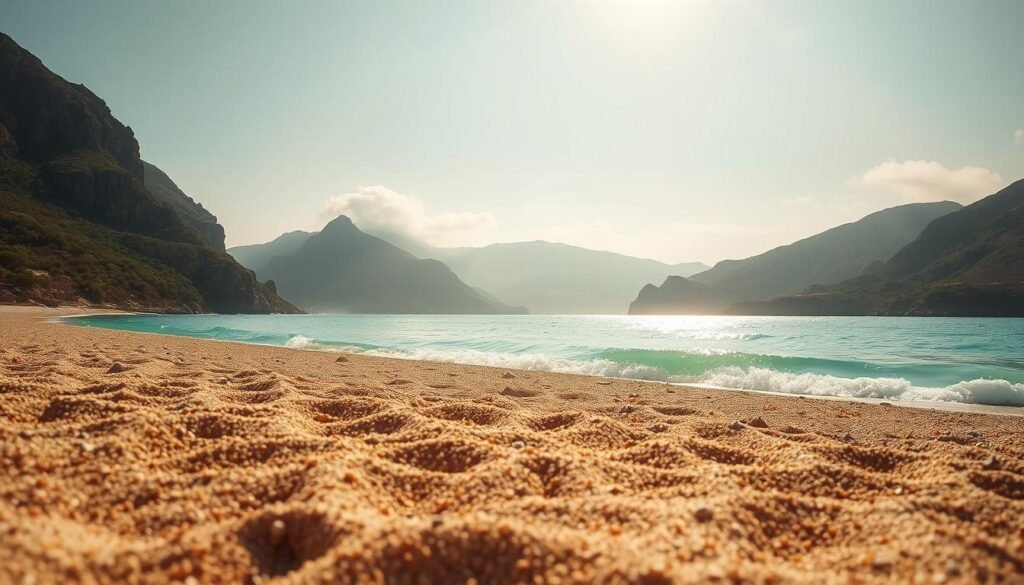
Naxos surprised me with a long ribbon of sand that invited slow, all-day wandering. The largest Cycladic island stretches a west-coast beach strip of more than 9 km, so I often moved from one shore to the next without ever leaving the sand.
Agios Prokopios, Agia Anna, and Plaka felt like one continuous, sandy playground. Calm waters made swims easy and mornings turned into long beach afternoons. I rented a car one day and linked the coastline with mountain villages for contrast.
Beaches, villages, and marble moments
- I watched the Portara frame sunset—its marble gate gave each evening a simple, ceremonial glow.
- Hopping into Apeiranthos and Halki introduced me to stone lanes, local cheeses, and citrus liqueurs.
- A Mt. Zeus hike delivered broad views and a satisfying summit without technical gear.
“With generous days of sun and calm waters, Naxos felt like a reset: simple food, slow walks, and quiet nights by the harbor.”
I appreciated the island’s Aegean location—it’s an easy hop from Mykonos or Paros yet much more low-key. For a quick guide to local Naxos sights and walking routes, that page helped me plan my most relaxed days.
Thassos: Marble Beaches, Pine-Clad Hills, and Peaceful Villages
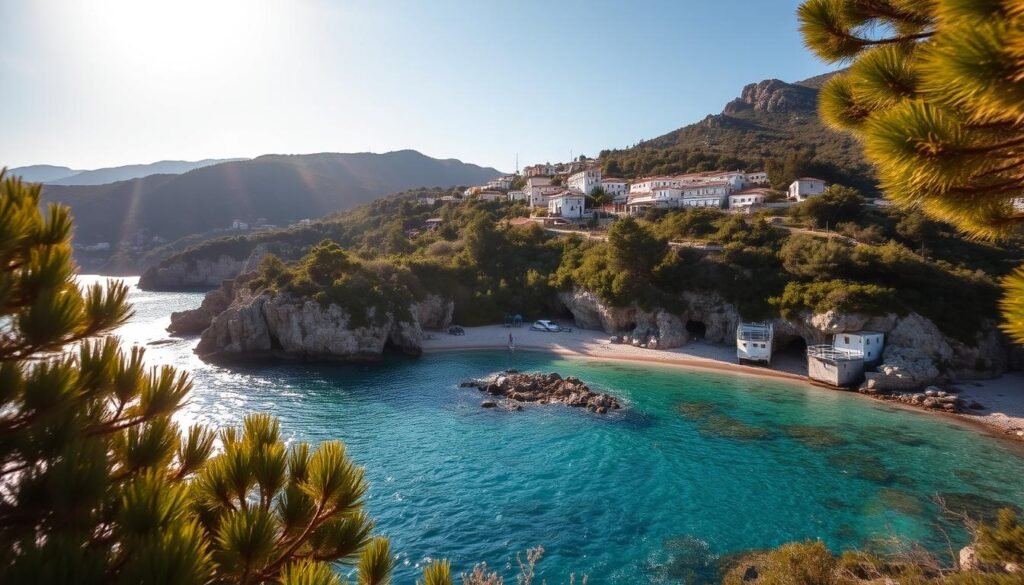
I found Thassos a gentle counterpoint to crowded islands: green slopes, pale coves, and calm evenings near the Aegean Sea. The island sits about six miles off the mainland and is an easy ferry hop from Keramoti or Kavala.
I spent slow days between Paradise Beach and Chrissi Ammoudia. Both beaches invite long swims and lingered lunches under umbrellas.
Marble Beach stopped me cold—white stones and electric water color. I arrived early to enjoy it before day-trippers showed up and to savor quiet views.
I hiked Ipsarion for pine-scented trails and a summit that framed the island’s curves and hidden coves. Limenas surprised me with ancient ruins near the port, a neat dose of history between swims.
The villages felt unhurried: Panagia became my dinner pick after sun-soaked days. Kayaking the clear waters and slipping into sea caves added a small adventure that stretched each day.
“I split my days—morning hikes, midday beaches, evening tavernas—and the island never felt rushed.”
| Feature | Spot | When I Recommend | Notes |
|---|---|---|---|
| Iconic shore | Marble Beach (Aliki area) | Early morning | Arrive early to avoid crowds and get the light |
| Great for swims | Paradise Beach / Chrissi Ammoudia | Midday | Long sandy stretches and calm waters |
| Hike & views | Ipsarion summit | Morning or late afternoon | Pine trails and sweeping island outlooks |
| Culture stop | Limenas (ancient Agora) | Any time between beach sessions | Compact ruins near modern port |
Lefkada: White Pebbles, Sheer Cliffs, and Turquoise Perfection
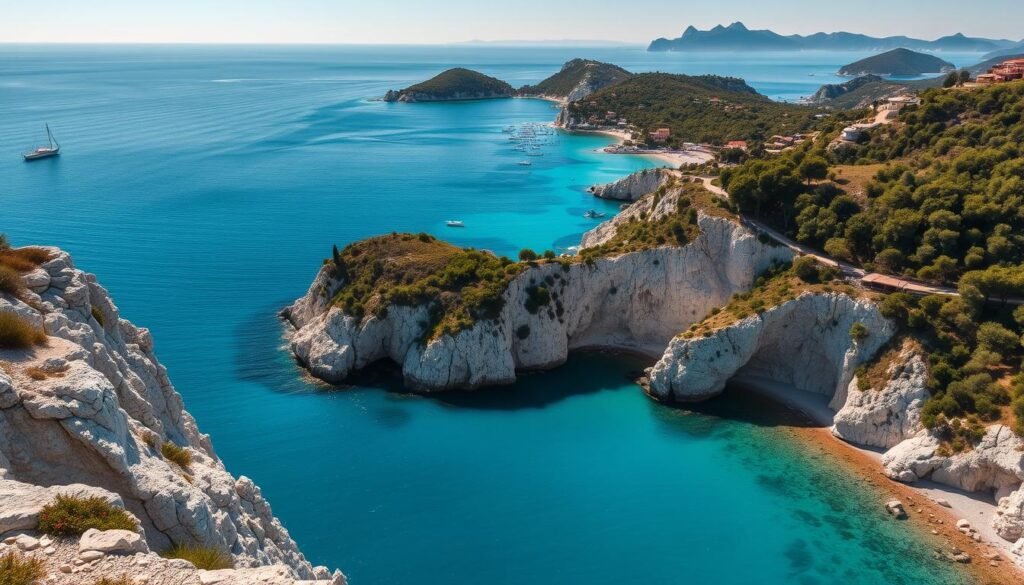
Driving across the floating bridge and causeway onto Lefkada made the arrival feel immediate and simple. The island’s link to the mainland means I could reach dramatic coastlines by car and still feel like I’d escaped.
I gasped at Porto Katsiki—the cliffs fell into glowing turquoise water and white pebbles that framed a perfect seaside view. Egremni shared that drama with a wilder vibe; the stair descent rewarded time on the sand.
Vassiliki showed me a different side: wind, sails, and easy rentals that turned an afternoon into a windsurfing grin. Nearby Nydri waterfalls gave shade and cool pools when I wanted a break from sun and salt.
Porto Katsiki and Egremni: world-class beach color
- I worked quieter coves between headline beaches so my week stayed balanced.
- I picked a boutique base with a balcony for west-coast sunsets.
- The island area is 302.5 sq km, so I used a car to link cliffs, bays, and boat rentals.
Water sports in Vassiliki and Nydri waterfalls
Bring a mask—the waters are unbelievably clear and invite quick snorkeling. Plan beach days by wind and light for peak color and comfort.
| Spot | Feature | Best time |
|---|---|---|
| Porto Katsiki | White-pebble shore, sheer cliffs, turquoise color | Morning or late afternoon for light |
| Egremni | Wilder beach, stair access, quieter when winds calm | Midday with water and snacks |
| Vassiliki / Nydri | Windsurfing hub; waterfalls and shaded pools nearby | Afternoons for wind; morning for hikes |
“Lefkada taught me to plan my beach sequence by wind and light for peak color and comfort.”
Beyond the Islands: Meteora and Delphi for Rock Formations and History
I remember the first time I rounded Meteora’s ridge and the pillars rose like a sudden city from stone. Meteora’s towering sandstone pillars hold active monasteries and offer unforgettable views for hikers and photographers. Trails between viewpoints made it easy for me to frame the spires and watch light shift across the valley.
Meteora’s monasteries sit atop unlikely rock formations, with frescoed chapels that link centuries of devotion and quiet artistry. The sense of scale and the raw rock underfoot made each step feel deliberate and good for reflection.
Delphi, on Mount Parnassus, gave me chills. The Temple of Apollo, theater, and stadium sit amid dramatic mountain views. I read about the oracle before going; that prep made the artifacts and layout resonate as true sites of ancient meaning and rich history.
I arranged travel from Athens with early departures so I had generous hours at each location. Bring layers and sturdy shoes—elevation and weather can change quickly compared with coastal plans. For photographers, sunrise and late afternoon yield the most dramatic shadows across these formations.
“Dedicate a full day to each—Meteora for its cliffs and monasteries, Delphi for the mountain ruins—and you’ll feel how many years of history shaped these landscapes.”
- Plan early departures from Athens for more time on-site.
- Wear layers and solid shoes for hikes and shifting weather.
- Allow extra time—both sites reward slow, unhurried exploration.
The Best Places to Visit in Greece: How I’d Plan Your First Trip
When I plan a first trip, I map routes that keep travel simple and sights plentiful.
My rule: pair one city night or two with an island group so you get history, beaches, and relaxed days without frantic transfers.
Island-hopping routes: Cyclades highlights vs. Ionian dreams
Cyclades option: Athens → Santorini → Naxos or Paros → Mykonos. Short ferry hops across the aegean sea make this an efficient circuit for cliff towns and iconic views.
Ionian option: Athens → Corfu → Lefkada → Kefalonia or Zakynthos for lush hills, big-cliff beaches, and calm water.
- I plan 2–3 nights per stop on most trips; add days if you want slow mornings and beach time.
- Crete or Rhodes work well as single-base options—airports and roads make logistics easy.
When to go: late spring or early fall
Late spring and early fall give the right balance of warm weather and fewer crowds. Summer draws high prices and fuller ferries, so I shift sightseeing to dawn or late afternoon then.
Hotel styles: boutique stays with sea views and easy beach access
I usually book sea-adjacent hotels with breezy terraces. A small boutique hotel often offers local tips and quieter mornings after a night of nightlife or a beach party.
| Group | Travel ease | Why choose |
|---|---|---|
| Cyclades | Frequent ferries | Cliff towns, compact hops |
| Ionian | Shorter drives | Turquoise water, sandy beaches |
| Crete / Rhodes | Airports & roads | Year-round options, fewer transfers |
“Group your route logically, book sea-adjacent rooms, and leave time for slow afternoons.”
Conclusion
What stayed with me longest were simple rhythms: a late swim, a long walk, and a slow dinner as light faded over the sea. Those small habits shaped how I remember the beaches, the towns, and the quiet views that made each trip feel like a return to life.
Give yourself time. Greece’s 16,000 km of coastline and 6,000+ islands reward lingering over landscapes, swapping big plans for a perfect swim, and savoring local cuisine at dusk.
Mix an Athens night or a mainland stop like Meteora with island hops for deeper history and softer sunsets. For quick reference on coastline and island facts, see this coastline and island facts.
Start where your heart tugs: pick a route, book that first ferry or flight, and let the islands and their waters welcome you back for another unforgettable sunset.


